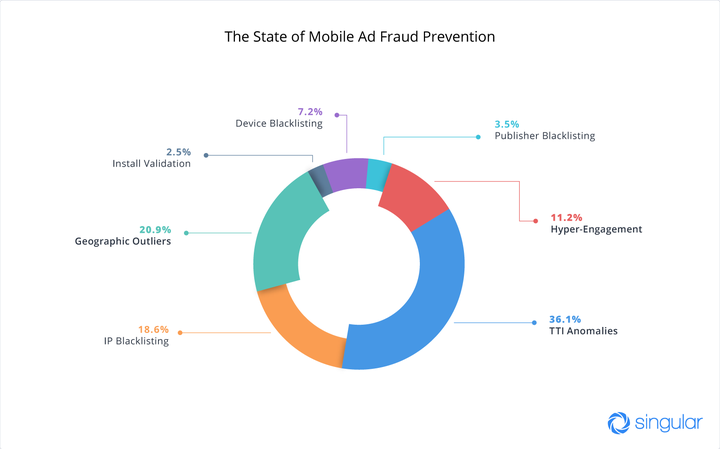Amid all the noise in the ad industry that data science and performance optimization can defeat mobile ad fraud, mobile marketers still suffer from persistently high fraud costs each year.
The fact of the matter is that while the ad industry loves to talk a big game about fraud, when it comes to actually doing something, the story is much different. More than 60 percent of marketers still lack active fraud prevention in their mobile marketing, recent data shows, emboldening fraudsters to exploit holes in analytics systems and develop new forms of fraud that evade the latest detection mechanisms.
But there are some marketers making progress in the fight against fraud. Our team took a deep dive into the latest mobile fraud data to examine how the world’s most sophisticated marketers are blocking fraud in real-time, before it can wreak havoc on their budgets and analytics.
The Singular Fraud Index is the first study of its kind to utilize mobile fraud data from multiple fraud prevention solutions, each with its own proprietary set of detection rules. With this unique dataset, we set out to answer two main questions: Which fraud signals are currently detecting and preventing the most fraud? And which media providers are doing the best job of keeping their sources clean?
We started by analyzing the many signals used by mobile marketers to block ad fraud in real-time. On the front lines of fraud prevention, when traffic is blocked and recorded as fraudulent, prevention systems send information about the signals used to detect the fraud, such as a “suspicious device” or a “blacklisted site”. By normalizing and aggregating these signals across billions of fraudulent engagements we were able to expose a breakdown of the top anti-fraud techniques that currently block the most mobile ad fraud:

One takeaway from this data is the numerous fraud signals that deserve credit for improving the industry’s ability to spot and block fraudulent activity in real-time. From IP Blacklisting to Time To Install (TTI) Anomalies, a multitude of detection methods play an important role in the first line of defense against modern-day attacks.
The most commonly triggered signals also shed light on where fraudsters are focusing their attacks. Hyper-Engagement Filters, Geographic Outliers and TTI Anomalies are all methods aimed at preventing attacks that try to steal credit from organic and paid sources, also known as attribution manipulation. The 70% of prevented fraud collectively blocked by these methods speaks to the prevalence of such attacks.
Attribution manipulation is a particularly destructive form of fraud as it not only costs companies their ad spend but also corrupts performance data, causing marketers to make poor acquisition decisions.
One way fraudsters steal credit for installs is by creating malicious apps that are legitimately downloaded by a user but, unbeknownst to the user, monitor the user’s device for installs and insert fake clicks before an app’s first open.

While marketers can’t do much about malicious apps finding their way onto users’ devices, they can ensure their attribution technologies are optimized to protect against attempts to hijack an install. One way is to utilize a fraud prevention solution that collects the timestamp of when an app’s file was downloaded, rather than the traditional technique of capturing the timestamp of an app’s first open. This capability — currently offered by Singular’s Fraud Prevention Suite — increases the accuracy and overall effectiveness of time to install filters used to block activity with irregular TTI statistics.
As analytics providers develop increasingly sophisticated detection methods and adapt to fraudsters’ ever-evolving attack patterns, so too must mobile ad networks work to ensure their traffic sources are protected.
That’s why we’ve decided to highlight in the report the 20 Most Secure Mobile Ad Networks in the industry. These networks drive significant volume to marketers while keeping mobile fraud rates well below the industry average. Mobile app marketers have long wondered where their ad dollars are safest — and we’re excited to finally provide the answer.
With new fraud indicators constantly popping up and research progressing at a rapid pace, there remains much more to be discovered and done.
Singular is committed to advancing fraud research in the industry and offering fraud solutions that leverages all known prevention methods to ensure maximum protection against existing and future threats.
Singular’s newly enhanced Fraud Prevention Suite, which is now available to all Singular customers, analyzes countless fraud signals at the most granular levels to identify illegitimate traffic, while Singular’s fraud prevention engine automatically applies rules at the time of attribution to stop fraud in its tracks, keeping sources clean and media budgets focused on quality users
Fraud is still a major problem for mobile marketers — and part of the blame lies with the analytics industry. Third-party analytics providers treat fraud prevention as a luxury, offering it to marketers as a ‘premium’ add-on rather than a free feature embedded in the platform. Equally problematic is the complexity of existing fraud offerings — for instance, attribution platforms that place the burden on marketers to run their own statistical analysis to detect fraud.
Singular is rapidly changing this paradigm with fraud prevention that is effective out of the box and free of charge for customers. Our enhanced Fraud Prevention Suite streamlines statistical fraud analysis and equips marketers with the most comprehensive set of built-in heuristics to detect and destroy increasingly sophisticated forms of fraud with unprecedented precision.
Marketers are badly in need of solutions that not only detect fraud across their media providers, but prevent it in real-time, and we’re excited to keep pushing the industry forward in the fight to keep ad dollars secure.